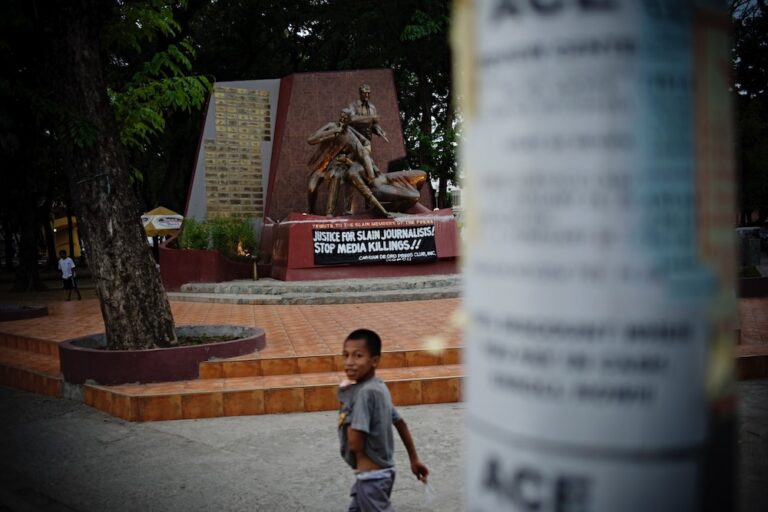On the 1,000th day anniversary of the 2009 Ampatuan Massacre, not much justice has been achieved, says the Philippines-based group Center for Media Freedom and Responsibility.
UPDATE: Maguindanao massacre suspect appeals to become a state witness (IFJ, 23 August 2012)
(CMFR/IFEX) – August 19, 2012 – The following is a statement by the Center for Media Freedom and Responsibility (CMFR) on the 1,000th day anniversary of the Ampatuan Massacre of November 23, 2009.
IT IS not entirely correct to say nothing has happened since 58 men and women including 32 journalists and media workers were killed in Ampatuan town, Maguindanao – a thousand days ago. Based on eyewitnesses’ account, it was a carefully planned and executed conspiracy involving key local politicians, their lieutenants and henchmen, and some one hundred members of their private army, which included members of the local paramilitaries and the police.
Since then a number of those accused have been indicted, and the petition for the dropping of charges against him by a member of the Ampatuan clan has been rejected by the Supreme Court. Some of those accused of planning and carrying out the Massacre are in custody. Hearings on the bail petitions of other accused individuals are also ongoing.
But it is not entirely correct to say either that there has been much justice achieved. The trial has not been the model of efficiency and speed one would expect of proceedings involving a crime of such magnitude. The Massacre has become the very embodiment of violence not only against the press, but also against ordinary citizens, who can only turn to government for justice. Dozens of those accused of involvement in this brutal crime are still to be arrested, and dozens more have not been indicted, even as criminal proceedings are caught in a neither-here-nor-there stage with bail hearings being held against some of the accused and trial on the merits for others in a case that is supposedly consolidated.
We can only say that the one thousand days have been days of continuing impunity.
Because the crime was a combined assault on the free press as a pillar of democracy, and on free elections as the primary means through which a free people choose their leaders, the quick resolution of the crime is imperative.
But almost from the very beginning of that trial, there were already disturbing indications, particularly when the spate of petitions, motions and other seemingly dilatory tactics employed by the defense now suggest that the trial can drag on indefinitely; encouraging further the killers not only of journalists but also of those other men and women fighting for change in a country that so sorely needs reform. If the Massacre has made anything clear, it is the difficulty of obtaining justice through a judicial system hostage to technicalities and susceptible to the crafty manipulation of lawyers.
As the Philippines approaches the third year since the Massacre took place, the Center for Media Freedom and Responsibility (CMFR) calls on every media and media advocacy organization as well as on civil society to demand that the police take into custody the dozens of others suspected of involvement in the Massacre, and that the prosecutorial services quickly file the appropriate charges against them and that they be as quickly indicted.
The CMFR, in furtherance of these imperatives, is preparing a series of briefings for the media, civil society, people’s organizations, and other citizens to enhance their awareness of the lack of progress in the Ampatuan trial and the immense stakes for democracy that are involved in its resolution.
We call on other media and media advocacy groups marking the massacre’s third year anniversary on November 23, 2012 to prepare and launch activities focused on accelerating the pace of the trial.
Above all, the public must be involved in exerting pressure on the entire justice system to accelerate the pace of the trial towards a credible resolution, calling on all high officials of government to do what they must in pursuit of justice for the slain and their families.


